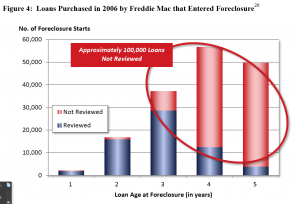Wells Fargo, Freddie, Bank of America, and UBS at DOJ
As a number of people have noted, Reuters has an important story on a potential conflict of interest at DOJ: Covington and Burling, where Eric Holder and Lanny Breuer worked before coming to DOJ in 2009, wrote key memos leading to the creation and title transfer abuses of MERS.
A particular concern by those pressing for an investigation is Covington’s involvement with Virginia-based MERS Corp, which runs a vast computerized registry of mortgages. Little known before the mortgage crisis hit, MERS, which stands for Mortgage Electronic Registration Systems, has been at the center of complaints about false or erroneous mortgage documents.
Court records show that Covington, in the late 1990s, provided legal opinion letters needed to create MERS on behalf of Fannie Mae, Freddie Mac, Bank of America, JP Morgan Chase and several other large banks. It was meant to speed up registration and transfers of mortgages. By 2010, MERS claimed to own about half of all mortgages in the U.S. — roughly 60 million loans.
But evidence in numerous state and federal court cases around the country has shown that MERS authorized thousands of bank employees to sign their names as MERS officials. The banks allegedly drew up fake mortgage assignments, making it appear falsely that they had standing to file foreclosures, and then had their own employees sign the documents as MERS “vice presidents” or “assistant secretaries.”
Covington in 2004 also wrote a crucial opinion letter commissioned by MERS, providing legal justification for its electronic registry. MERS spokeswoman Karmela Lejarde declined to comment on Covington legal work done for MERS.
In the two years before they joined the Administration, Holder did over $5,000 of legal work for Bank of America and UBS. Breuer did over $5,000 of legal work for Freddie Mac and Wells Fargo.
That of course doesn’t reveal whether they were involved in the key 2004 letter–but it shows they did some kind of work for the most corrupt banks during the financial crash.
But Cynthia Kouril explains why the normal 2-year disclosure rules on this issue aren’t enough.
If DOJ were to bring criminal charges against the big banks for all the mortgage fraud, it would be really tough to do so without attacking MERS and the status of the alleged transfers made within MERS. A conclusive finding that MERS is and always was the dumbest idea on earth and that any L1 law student should have been able to see that, will destroy the law firm.
Even if Holder and Breuer are not planning to return to Covington after their stint in public service, their pensions are presumable tied to the viability of the firm.
That is, whoever signed off on the legal justification for MERS is a shitty lawyer. And for DOJ to go after the banks, a key part of that argument would require arguing that their former firm is a shitty lawyer. They may have big reasons not to want to do that.
Update: Recall that during the fight over Cheney’s interview report, Breuer did not disclose that he had helped Jon Kiriakou avoid testifying about who ordered him to investigate the Joe Wilson trip at the CIA. While temporally, he complied with his ethical guidelines, it was still the kind of thing he should have disclosed.

